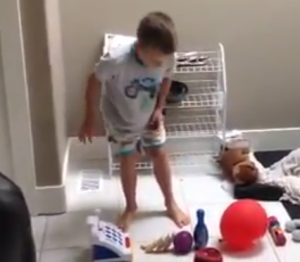The “Internet of things” (IoT) is becoming an increasingly growing topic of conversation both in the workplace and outside of it. It’s a concept that not only has the potential to impact how we live but also how we work. But what exactly is the “Internet of things” and what impact is it going to have on you if any? There are a lot of complexities around the “Internet of things” but I want to stick to the basics. Lots of technical and policy related conversations are being had but many people are still just trying to grasp the foundation of what the heck these conversations are about. Let’s start with understanding a few things. Broadband Internet is become more widely available, the cost of connecting is decreasing, more devices are being created with wifi capabilities and censors built into them, technology costs are going down, and smart phone penetration is sky-rocketing. All of these things are creating a “perfect storm” for the IoT.  So what is the Internet of things? Simply put this is the concept of basically connecting any device with an on and off switch to the Internet (and/or to each other). This includes everything from cell phones, coffee makers, washing machines, headphones, lamps, wearable devices and almost anything else you can think of. This also applies to components of machines, for example a jet engine of an airplane or the drill of an oil rig. As I mentioned, if it has an on and off switch then chances are it can be a part of the IoT. The analyst firm Gartner says that by 2020 there will be over 26 billion connected devices…that’s a lot of connections (some even estimate this number to be much higher, over 100 billion). The IoT is a giant network of connected “things” (which also includes people). The relationship will be between people-people, people-things, and things-things. How does this impact you? The new rule for the future is going to be, “anything that can be connected, will be connected.” But why on earth would you want so many connected devices talking to each other? There are many examples for what this might look like or what the potential value might be. Say for example you are on your way to a meeting, your car could have access to your calendar and already know the best route to take, if the traffic is heavy your car might send a text to the other party notifying them that you will be late. What if your alarm clock wakes up you at 6 am and then notifies your coffee maker to start brewing coffee for you? What if your office equipment knew when it was running low on supplies and automatically re-ordered more? What if the wearable device you used in the workplace could tell you when and where you were most active and productive and shared that information with other devices that you used while working? On a broader scale the IoT can be applied to things like transportation networks “smart cities” which can help us reduce waste and improve efficiency for things such as energy use; this helping us understand and improve how we work and live. Take a look at the visual below to see what something like that can look like.
So what is the Internet of things? Simply put this is the concept of basically connecting any device with an on and off switch to the Internet (and/or to each other). This includes everything from cell phones, coffee makers, washing machines, headphones, lamps, wearable devices and almost anything else you can think of. This also applies to components of machines, for example a jet engine of an airplane or the drill of an oil rig. As I mentioned, if it has an on and off switch then chances are it can be a part of the IoT. The analyst firm Gartner says that by 2020 there will be over 26 billion connected devices…that’s a lot of connections (some even estimate this number to be much higher, over 100 billion). The IoT is a giant network of connected “things” (which also includes people). The relationship will be between people-people, people-things, and things-things. How does this impact you? The new rule for the future is going to be, “anything that can be connected, will be connected.” But why on earth would you want so many connected devices talking to each other? There are many examples for what this might look like or what the potential value might be. Say for example you are on your way to a meeting, your car could have access to your calendar and already know the best route to take, if the traffic is heavy your car might send a text to the other party notifying them that you will be late. What if your alarm clock wakes up you at 6 am and then notifies your coffee maker to start brewing coffee for you? What if your office equipment knew when it was running low on supplies and automatically re-ordered more? What if the wearable device you used in the workplace could tell you when and where you were most active and productive and shared that information with other devices that you used while working? On a broader scale the IoT can be applied to things like transportation networks “smart cities” which can help us reduce waste and improve efficiency for things such as energy use; this helping us understand and improve how we work and live. Take a look at the visual below to see what something like that can look like.
The SAN Script – the week of December 1 – 5

Art makes life bearable. It isn’t a luxury. Like our capacity for understanding, and our experience of love, it is a vitally important part of life.
– Gillian Pederson Krag
even hip hop!
St. Anthony this week this week
Monday, December 1
Donna is in this week – Krista will be returning to us on December 8th!
Meg, Paul and Nora out at the board – digital portfolios (AM)
Aviva Semi finals start at noon today – please vote for our school!! This is a 10-day campaign so every day counts!!
https://www.avivacommunityfund.org/ideas/acf19604
Squirmies today (Last day) 11:35
Advent Week One celebration in the gym (2:00 PM)
waste walkabout
remember to get a gift ($15.00 max)for the gift exchange!
Tuesday, December 2
Franck in today to work on configurator – we need all your iPads and iPods by Tuesday morning
Vote for our school! https://www.avivacommunityfund.org/ideas/acf19604
Chess today 11:35
Volunteer in Mrs. Rupnik’s PM class, Dorothy Stanyar- Reading with students
Wednesday, December 3
Vote for our school! https://www.avivacommunityfund.org/ideas/acf19604
waste walkabout
Rosary visits to St. Anthony
Paul away – Family of Schools meeting 12:00 PM
Every 1st Wednesday of the month, beginning October 1st
JK AM is FDK 1, 10:00 to 10:20
Grade 1/2 Ms.Myers; 12:15 to 12:35
Grade 2/3 Mrs. Manzoli 12:35 to 12:55
Grade 1/2 Mr. Cook; 12:35 to 12:55
Grade 4/5 is M. Girard; 12:55 to 1:25
SK PM is FDK 2, 1:45 to 2:05
Grade 5/6 is Ms. Hubert; 1:45 to 2:30
Last session of young Rembrandts
Thursday, December 4
Vote for our school! https://www.avivacommunityfund.org/ideas/acf19604
Kathi, SLP, in Mrs. Rupnik’s Class
Friday, December 5
Memorial Mass for Meg’s mother at St. Anthony Church – 7:30 am
Vote for our school! https://www.avivacommunityfund.org/ideas/acf19604
waste walkabout
Hip Hop Little Horn Theatre
* HIP HOP Katie St. Anthony’s
JK/SK 8:30-9:00 (20)
JK/SK 9:00-9:30 (20)
9:45-10:00 recess
10:00-10:40 Grade 1 ( 12) +
Grade 1/2 (20)
10:40-11:15 Grade 2/3 (16) *get
ready for lunch upon dismissal
11:15-12:15 LUNCH
12:30-1:10 Grade 4/5 (24)
1:30-1:45 LAST RECESS
2:00-2:40 Grade 5/6 (24)
Christmas staff social at Mill Street Brew Pub starting at 5:00PM – don’t forget your gift!
A Simple Explanation Of ‘The Internet Of Things’
 this is a really cool topic – to learn more, please go to here
this is a really cool topic – to learn more, please go to here






















